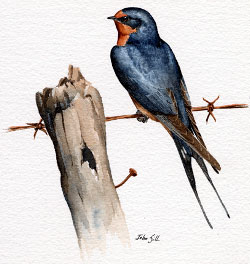Breeding Bird Atlases (BBA)
Find a Bird - BBA1
Breeding Bird Atlas 1 Species Accounts
Barn Swallow
Hirundo rustica
Egg Dates
May 17 to July 24
Number of Broods
one or two

The Barn Swallow is a widespread and common breeding bird throughout Massachusetts. To many people it is as reliable a harbinger of spring as the robin. Historically, Barn Swallows nested under cliffs and rock ledges, in caves (as at Nahant), and under branches of large trees; but the birds switched to using human-built structures with the advent of European civilization. This habit quickly became nearly universal, and today Barn Swallows utilize garages, carports, abandoned buildings, barns, sheds, porches, bridges, wharves, and boathouses. Open fields, bodies of water, or marshland provide favored feeding areas over which the birds catch insects. In many parts of Massachusetts, the Barn Swallow population has started to decline as urban and suburban sprawl engulfs farmlands, thus eliminating prime feeding and nesting areas.
Adult swallows return year after year to the same nesting site. Most young swallows return to the general area where they were born, but only occasional individuals return to their natal colony. Although there are records in Massachusetts of pairs nesting singly, most Barn Swallows gather in colonies of several to 45 pairs. Bent states that 7 or 9 nests per barn are typical, and he mentions a barn in Ipswich that held 55 nests.
The first birds to return in the spring are invariably males, which arrive from mid- to late April, depending on the advent of warm weather. April 18 is the most frequent date of arrival at one colony on upper Cape Cod. These early males may retreat if the weather turns cool but quickly return. The bulk of the nesting population has arrived by mid-May, but some continue to trickle in to the end of the month.
Barn Swallows keep up an almost constant chorus of chattering and twittering at their colonies from April through August. Songs are a combination of a series of jumbled, rapid, twittering szee-szah notes with harsh, rattling burps or trills interspersed or at the end. Calls to young and other members of the colony consist of soft yit-yit or kyit-kyit sounds. Colony defense consists of birds diving at intruders while uttering shrill ee-tee or keet alarm calls. Some well-established colonies will not tolerate any other type of bird, even Cliff Swallows, near the nests, but at other times Barn and Cliff swallows will share a site.
Courting males sing and pursue the paler colored females. Pairs may also perch close together and preen one another. Barn Swallows prefer to repair and reuse old nests rather than build new ones. When new construction is necessary, both sexes will work on fashioning the nest from layers of mud and grass with a lining of clean, white feathers. The birds generally choose beams, ledges, platforms, light fixtures, and even nails to provide some support for the nest. Overhead protection with 1 to 3 inches above the top of the nests is preferred. In places where nests are built with a lot of overhead space, additions in subsequent years will result in unusually high nests being built. Weather conditions and availability of building materials influence the rate of nest construction, which may take 12 days or more. As much as two weeks may pass between completion of the nest and the laying of eggs. The following breakdown for locations of 89 state nests will give some idea of the diversity of sites: shed (6 nests), barn (39 nests), garage (4 nests), cabin (1 nest), factory (4 nests), warehouse (10 nests), unspecified building (8 nests), porch/light fixture (5 nests), bridge (12 nests) (CNR, Meservey). Heights for 32 of these nests ranged from 3 to 25 feet, with an average of 10 feet (CNR).
Beginning in mid-May, the first eggs are laid. A clutch consists of two to six brown-speckled, white eggs, with second clutches averaging slightly fewer. Once the set is complete, the female incubates for 12 to 16 (average 15) days. The clutch sizes for 12 Massachusetts nests were four eggs (5 nests), five eggs (6 nests), six eggs (1 nest) (DKW, CNR). Known state hatch dates were: June 14 and 29 and July 27 and 28 (CNR). The young remain in the nest for about three weeks. After fledging they are fed in flight or on perches, where they wait to greet the parents with wing fluttering, open bills, and a rapid, chattering, begging call. Many adults begin a second nesting in early July while the first brood of young remains in the general area. In Massachusetts, nestlings have been reported from June 4 to August 21, and dependent fledglings have been recorded from June 27 to September 2 (CNR, Meservey). Known state fledging dates were June 27; July 4, 5, and 23; and August 16, 17, 18, 20, and 21 (CNR). Brood sizes for 28 state nests were three young (5 nests), four young (10 nests), five young (11 nests), six young (2 nests) (CNR).
Near the end of August, as the last few fledglings leave the nest, families of Barn Swallows can be seen congregating on roadside wires where they are gradually joined by other adults and older young. At this time, they may mingle with other species of swallows. Gradually, the numbers decrease as birds begin their southward migration. Fall migration extends from mid-August to mid-September, but occasional lingerers are noted in October and even November. Molting occurs after migration. The wintering grounds are in the Caribbean Islands and Central and South America.
Map Legend and Data Summary
Atlas 1 data collected from 1975-1979


Note: common or abundant throughout the state; nests within barns or similar structures
Elwood O. Mills,Jr.



